SUZUKI GRAND VITARA 2022 Owners Manual
Manufacturer: SUZUKI, Model Year: 2022, Model line: GRAND VITARA, Model: SUZUKI GRAND VITARA 2022Pages: 482, PDF Size: 21 MB
Page 151 of 482
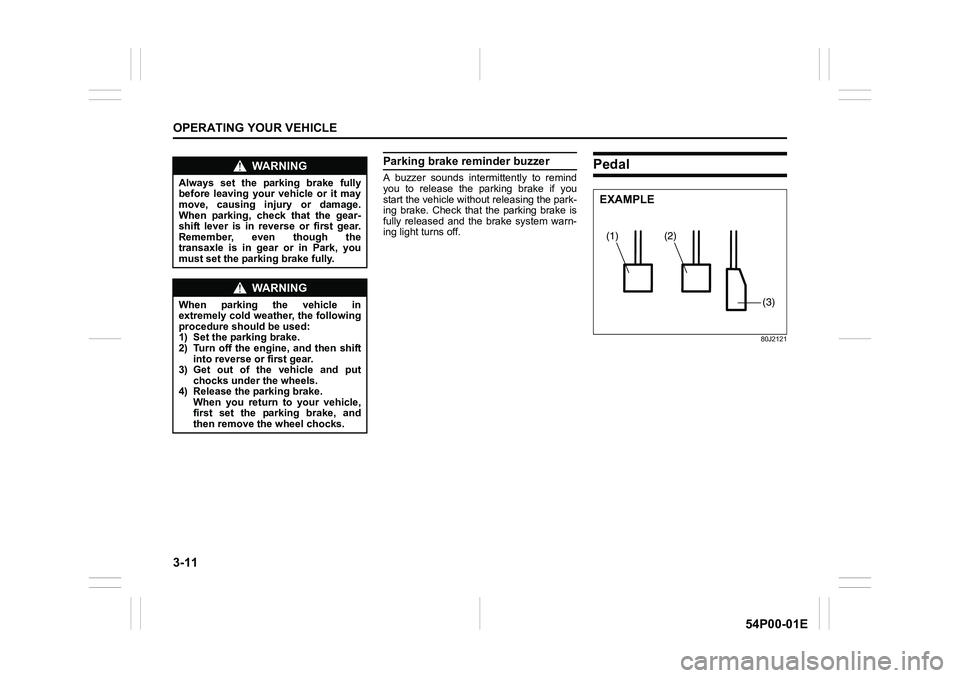
3-11
OPERATING YOUR VEHICLE
54P00-01E
Parking brake reminder buzzer
A buzzer sounds intermittently to remind
you to release the parking brake if you
start the vehicle without releasing the park-
ing brake. Check that the parking brake is
fully released and the brake system warn-
ing light turns off.
Pedal
80J2121
WA R N I N G
Always set the parking brake fully
before leaving your vehicle or it may
move, causing injury or damage.
When parking, check that the gear-
shift lever is in reverse or first gear.
Remember, even though the
transaxle is in gear or in Park, you
must set the parking brake fully.
WA R N I N G
When parking the vehicle in
extremely cold weather, the following
procedure should be used:
1) Set the parking brake.
2) Turn off the engine, and then shift
into reverse or first gear.
3) Get out of the vehicle and put
chocks under the wheels.
4) Release the parking brake.
When you return to your vehicle,
first set the parking brake, and
then remove the wheel chocks.
(2)(1)
(3)
EXAMPLE
Page 152 of 482
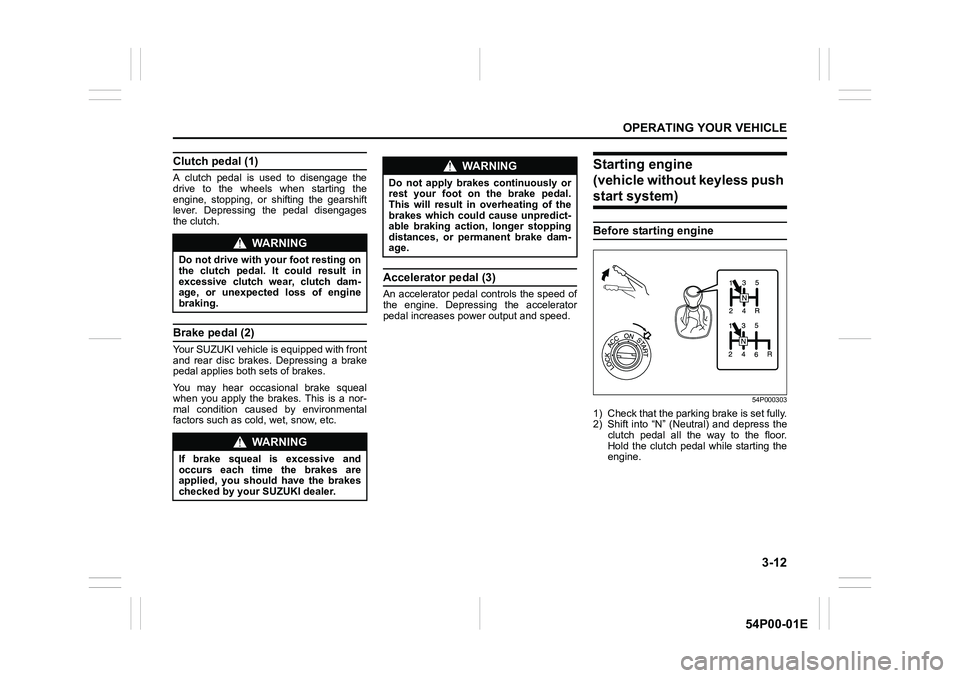
3-12
OPERATING YOUR VEHICLE
54P00-01E
Clutch pedal (1)
A clutch pedal is used to disengage the
drive to the wheels when starting the
engine, stopping, or shifting the gearshift
lever. Depressing the pedal disengages
the clutch.
Brake pedal (2)
Your SUZUKI vehicle is equipped with front
and rear disc brakes. Depressing a brake
pedal applies both sets of brakes.
You may hear occasional brake squeal
when you apply the brakes. This is a nor-
mal condition caused by environmental
factors such as cold, wet, snow, etc.
Accelerator pedal (3)
An accelerator pedal controls the speed of
the engine. Depressing the accelerator
pedal increases power output and speed.
Starting engine
(vehicle without keyless push
start system)
Before starting engine
54P000303
1) Check that the parking brake is set fully.
2) Shift into “N” (Neutral) and depress the
clutch pedal all the way to the floor.
Hold the clutch pedal while starting the
engine.
WA R N I N G
Do not drive with your foot resting on
the clutch pedal. It could result in
excessive clutch wear, clutch dam-
age, or unexpected loss of engine
braking.
WA R N I N G
If brake squeal is excessive and
occurs each time the brakes are
applied, you should have the brakes
checked by your SUZUKI dealer.
WA R N I N G
Do not apply brakes continuously or
rest your foot on the brake pedal.
This will result in overheating of the
brakes which could cause unpredict-
able braking action, longer stopping
distances, or permanent brake dam-
age.
Page 153 of 482
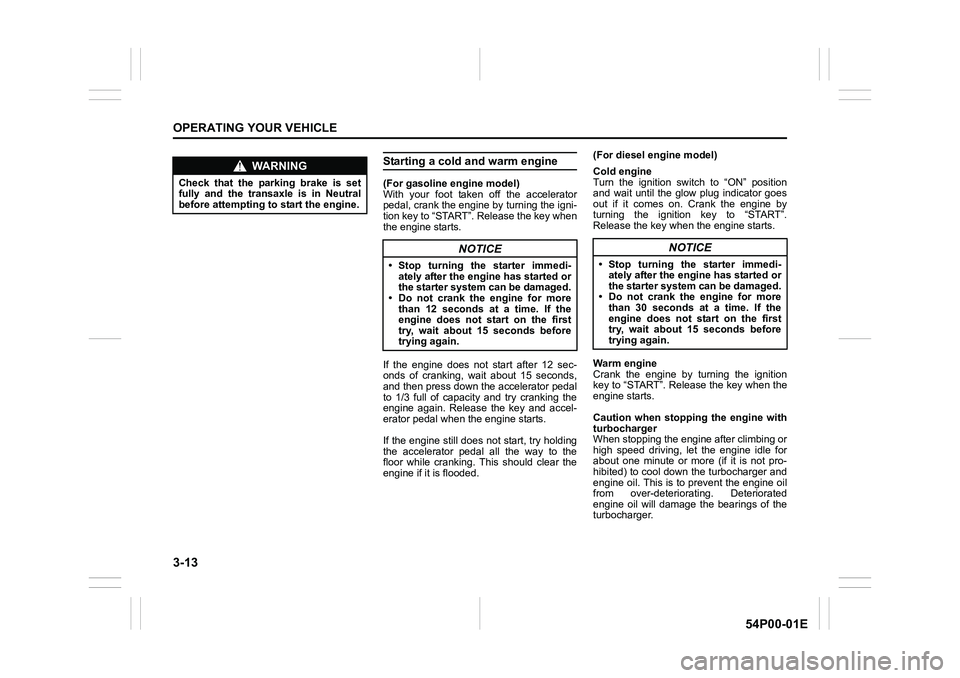
3-13
OPERATING YOUR VEHICLE
54P00-01E
Starting a cold and warm engine
(For gasoline engine model)
With your foot taken off the accelerator
pedal, crank the engine by turning the igni-
tion key to “START”. Release the key when
the engine starts.
If the engine does not start after 12 sec-
onds of cranking, wait about 15 seconds,
and then press down the accelerator pedal
to 1/3 full of capacity and try cranking the
engine again. Release the key and accel-
erator pedal when the engine starts.
If the engine still does not start, try holding
the accelerator pedal all the way to the
floor while cranking. This should clear the
engine if it is flooded.(For diesel engine model)
Cold engine
Turn the ignition switch to “ON” position
and wait until the glow plug indicator goes
out if it comes on. Crank the engine by
turning the ignition key to “START”.
Release the key when the engine starts.
Warm engine
Crank the engine by turning the ignition
key to “START”. Release the key when the
engine starts.
Caution when stopping the engine with
turbocharger
When stopping the engine after climbing or
high speed driving, let the engine idle for
about one minute or more (if it is not pro-
hibited) to cool down the turbocharger and
engine oil. This is to prevent the engine oil
from over-deteriorating. Deteriorated
engine oil will damage the bearings of the
turbocharger.
WA R N I N G
Check that the parking brake is set
fully and the transaxle is in Neutral
before attempting to start the engine.
NOTICE
• Stop turning the starter immedi-
ately after the engine has started or
the starter system can be damaged.
• Do not crank the engine for more
than 12 seconds at a time. If the
engine does not start on the first
try, wait about 15 seconds before
trying again.
NOTICE
• Stop turning the starter immedi-
ately after the engine has started or
the starter system can be damaged.
• Do not crank the engine for more
than 30 seconds at a time. If the
engine does not start on the first
try, wait about 15 seconds before
trying again.
Page 154 of 482
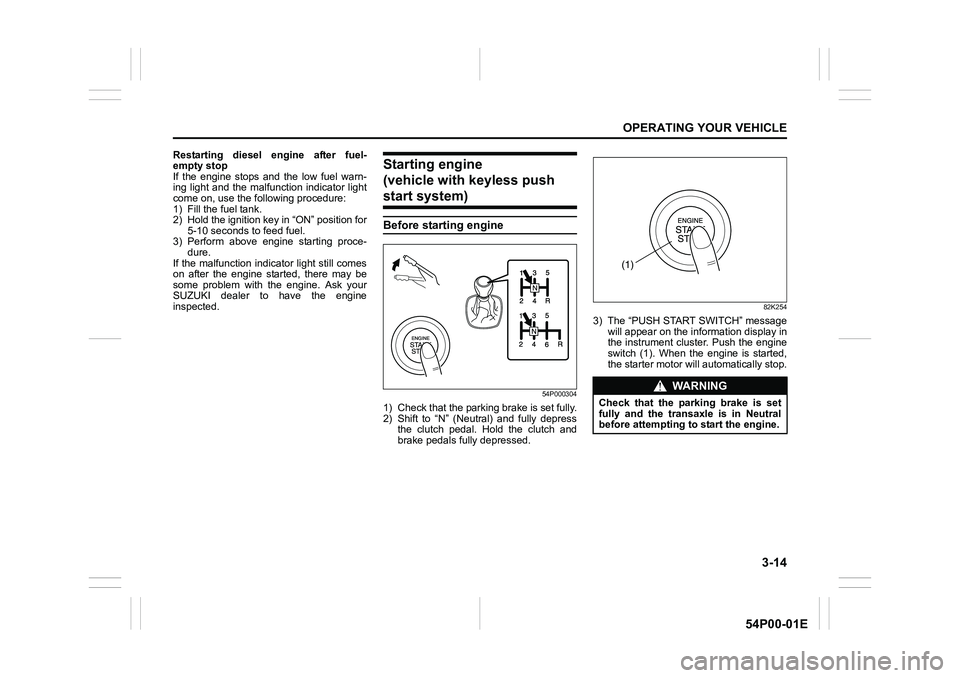
3-14
OPERATING YOUR VEHICLE
54P00-01E
Restarting diesel engine after fuel-
empty stop
If the engine stops and the low fuel warn-
ing light and the malfunction indicator light
come on, use the following procedure:
1) Fill the fuel tank.
2) Hold the ignition key in “ON” position for
5-10 seconds to feed fuel.
3) Perform above engine starting proce-
dure.
If the malfunction indicator light still comes
on after the engine started, there may be
some problem with the engine. Ask your
SUZUKI dealer to have the engine
inspected.Starting engine
(vehicle with keyless push
start system)
Before starting engine
54P000304
1) Check that the parking brake is set fully.
2) Shift to “N” (Neutral) and fully depress
the clutch pedal. Hold the clutch and
brake pedals fully depressed.
82K254
3) The “PUSH START SWITCH” message
will appear on the information display in
the instrument cluster. Push the engine
switch (1). When the engine is started,
the starter motor will automatically stop.
WA R N I N G
Check that the parking brake is set
fully and the transaxle is in Neutral
before attempting to start the engine.
(1)
Page 155 of 482
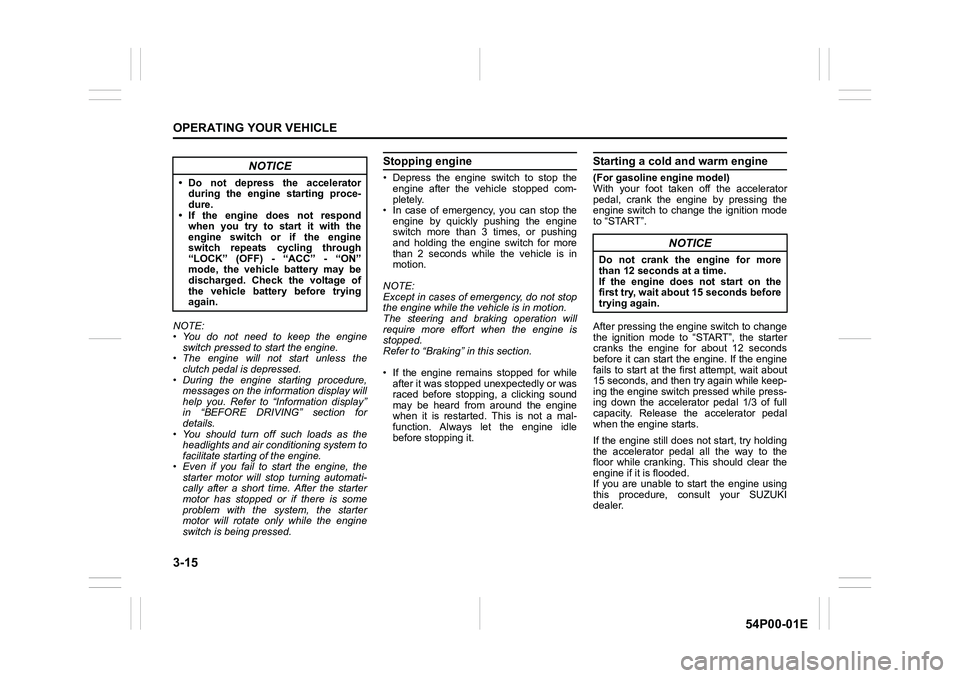
3-15
OPERATING YOUR VEHICLE
54P00-01E
NOTE:
• You do not need to keep the engine
switch pressed to start the engine.
• The engine will not start unless the
clutch pedal is depressed.
• During the engine starting procedure,
messages on the information display will
help you. Refer to “Information display”
in “BEFORE DRIVING” section for
details.
• You should turn off such loads as the
headlights and air conditioning system to
facilitate starting of the engine.
• Even if you fail to start the engine, the
starter motor will stop turning automati-
cally after a short time. After the starter
motor has stopped or if there is some
problem with the system, the starter
motor will rotate only while the engine
switch is being pressed.
Stopping engine
• Depress the engine switch to stop the
engine after the vehicle stopped com-
pletely.
• In case of emergency, you can stop the
engine by quickly pushing the engine
switch more than 3 times, or pushing
and holding the engine switch for more
than 2 seconds while the vehicle is in
motion.
NOTE:
Except in cases of emergency, do not stop
the engine while the vehicle is in motion.
The steering and braking operation will
require more effort when the engine is
stopped.
Refer to “Braking” in this section.
• If the engine remains stopped for while
after it was stopped unexpectedly or was
raced before stopping, a clicking sound
may be heard from around the engine
when it is restarted. This is not a mal-
function. Always let the engine idle
before stopping it.
Starting a cold and warm engine
(For gasoline engine model)
With your foot taken off the accelerator
pedal, crank the engine by pressing the
engine switch to change the ignition mode
to “START”.
After pressing the engine switch to change
the ignition mode to “START”, the starter
cranks the engine for about 12 seconds
before it can start the engine. If the engine
fails to start at the first attempt, wait about
15 seconds, and then try again while keep-
ing the engine switch pressed while press-
ing down the accelerator pedal 1/3 of full
capacity. Release the accelerator pedal
when the engine starts.
If the engine still does not start, try holding
the accelerator pedal all the way to the
floor while cranking. This should clear the
engine if it is flooded.
If you are unable to start the engine using
this procedure, consult your SUZUKI
dealer.NOTICE
• Do not depress the accelerator
during the engine starting proce-
dure.
• If the engine does not respond
when you try to start it with the
engine switch or if the engine
switch repeats cycling through
“LOCK” (OFF) - “ACC” - “ON”
mode, the vehicle battery may be
discharged. Check the voltage of
the vehicle battery before trying
again.
NOTICE
Do not crank the engine for more
than 12 seconds at a time.
If the engine does not start on the
first try, wait about 15 seconds before
trying again.
Page 156 of 482
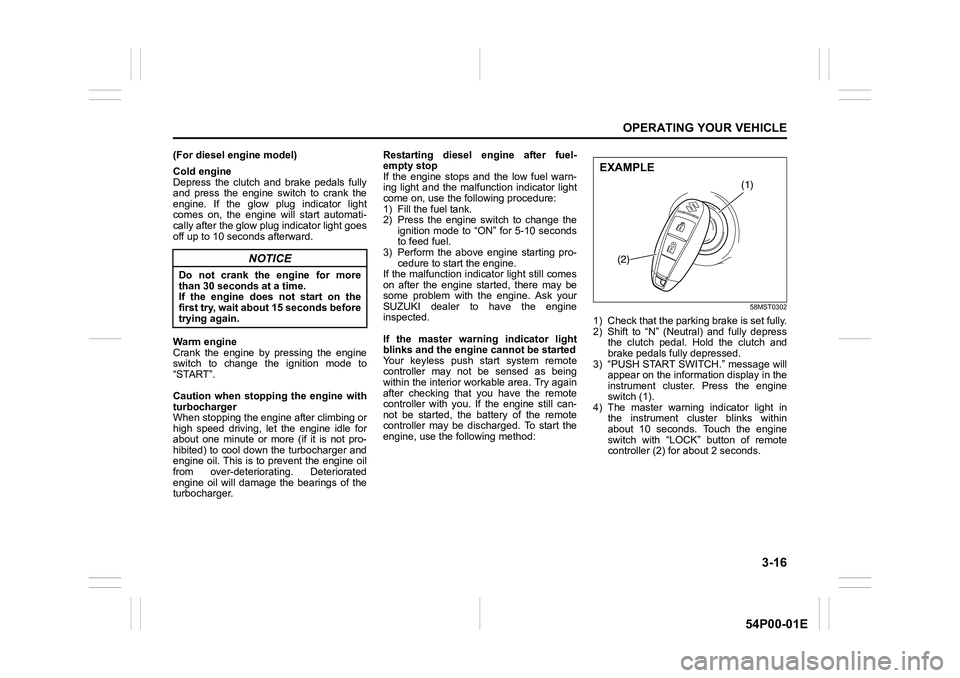
3-16
OPERATING YOUR VEHICLE
54P00-01E
(For diesel engine model)
Cold engine
Depress the clutch and brake pedals fully
and press the engine switch to crank the
engine. If the glow plug indicator light
comes on, the engine will start automati-
cally after the glow plug indicator light goes
off up to 10 seconds afterward.
Warm engine
Crank the engine by pressing the engine
switch to change the ignition mode to
“START”.
Caution when stopping the engine with
turbocharger
When stopping the engine after climbing or
high speed driving, let the engine idle for
about one minute or more (if it is not pro-
hibited) to cool down the turbocharger and
engine oil. This is to prevent the engine oil
from over-deteriorating. Deteriorated
engine oil will damage the bearings of the
turbocharger.Restarting diesel engine after fuel-
empty stop
If the engine stops and the low fuel warn-
ing light and the malfunction indicator light
come on, use the following procedure:
1) Fill the fuel tank.
2) Press the engine switch to change the
ignition mode to “ON” for 5-10 seconds
to feed fuel.
3) Perform the above engine starting pro-
cedure to start the engine.
If the malfunction indicator light still comes
on after the engine started, there may be
some problem with the engine. Ask your
SUZUKI dealer to have the engine
inspected.
If the master warning indicator light
blinks and the engine cannot be started
Your keyless push start system remote
controller may not be sensed as being
within the interior workable area. Try again
after checking that you have the remote
controller with you. If the engine still can-
not be started, the battery of the remote
controller may be discharged. To start the
engine, use the following method:
58MST0302
1) Check that the parking brake is set fully.
2) Shift to “N” (Neutral) and fully depress
the clutch pedal. Hold the clutch and
brake pedals fully depressed.
3) “PUSH START SWITCH.” message will
appear on the information display in the
instrument cluster. Press the engine
switch (1).
4) The master warning indicator light in
the instrument cluster blinks within
about 10 seconds. Touch the engine
switch with “LOCK” button of remote
controller (2) for about 2 seconds.
NOTICE
Do not crank the engine for more
than 30 seconds at a time.
If the engine does not start on the
first try, wait about 15 seconds before
trying again.
(1)
(2)
EXAMPLE
Page 157 of 482
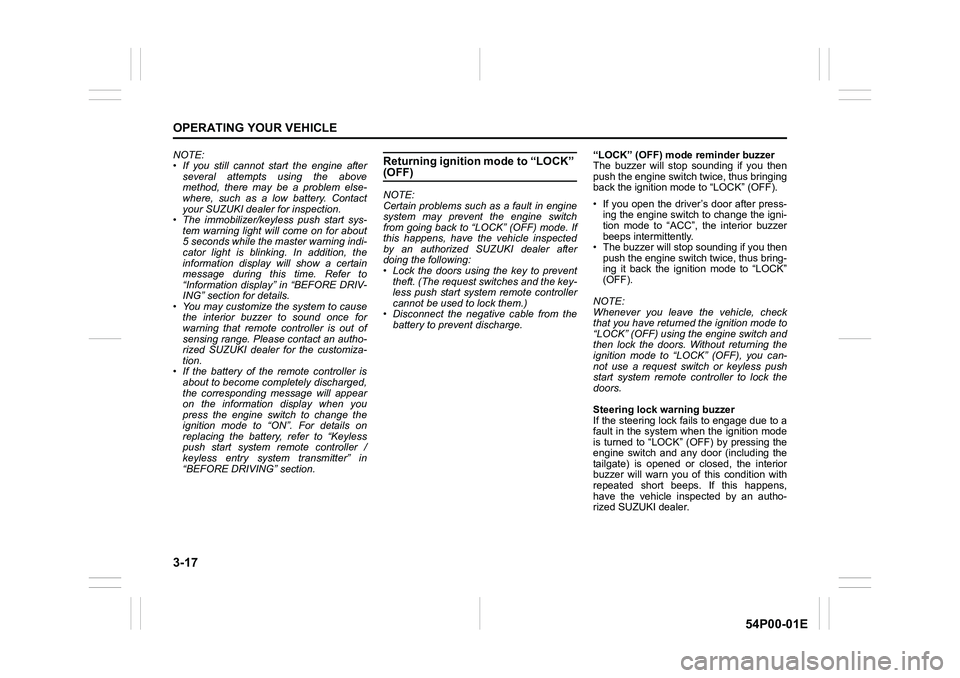
3-17
OPERATING YOUR VEHICLE
54P00-01E
NOTE:
• If you still cannot start the engine after
several attempts using the above
method, there may be a problem else-
where, such as a low battery. Contact
your SUZUKI dealer for inspection.
• The immobilizer/keyless push start sys-
tem warning light will come on for about
5 seconds while the master warning indi-
cator light is blinking. In addition, the
information display will show a certain
message during this time. Refer to
“Information display” in “BEFORE DRIV-
ING” section for details.
• You may customize the system to cause
the interior buzzer to sound once for
warning that remote controller is out of
sensing range. Please contact an autho-
rized SUZUKI dealer for the customiza-
tion.
• If the battery of the remote controller is
about to become completely discharged,
the corresponding message will appear
on the information display when you
press the engine switch to change the
ignition mode to “ON”. For details on
replacing the battery, refer to “Keyless
push start system remote controller /
keyless entry system transmitter” in
“BEFORE DRIVING” section.Returning ignition mode to “LOCK” (OFF)
NOTE:
Certain problems such as a fault in engine
system may prevent the engine switch
from going back to “LOCK” (OFF) mode. If
this happens, have the vehicle inspected
by an authorized SUZUKI dealer after
doing the following:
• Lock the doors using the key to prevent
theft. (The request switches and the key-
less push start system remote controller
cannot be used to lock them.)
• Disconnect the negative cable from the
battery to prevent discharge.“LOCK” (OFF) mode reminder buzzer
The buzzer will stop sounding if you then
push the engine switch twice, thus bringing
back the ignition mode to “LOCK” (OFF).
• If you open the driver’s door after press-
ing the engine switch to change the igni-
tion mode to “ACC”, the interior buzzer
beeps intermittently.
• The buzzer will stop sounding if you then
push the engine switch twice, thus bring-
ing it back the ignition mode to “LOCK”
(OFF).
NOTE:
Whenever you leave the vehicle, check
that you have returned the ignition mode to
“LOCK” (OFF) using the engine switch and
then lock the doors. Without returning the
ignition mode to “LOCK” (OFF), you can-
not use a request switch or keyless push
start system remote controller to lock the
doors.
Steering lock warning buzzer
If the steering lock fails to engage due to a
fault in the system when the ignition mode
is turned to “LOCK” (OFF) by pressing the
engine switch and any door (including the
tailgate) is opened or closed, the interior
buzzer will warn you of this condition with
repeated short beeps. If this happens,
have the vehicle inspected by an autho-
rized SUZUKI dealer.
Page 158 of 482
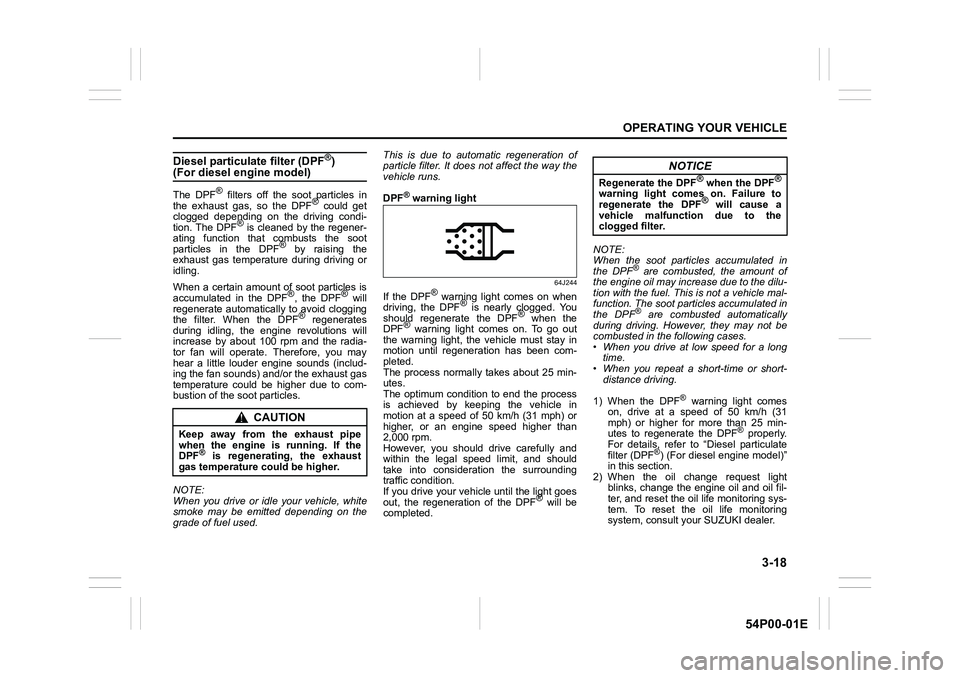
3-18
OPERATING YOUR VEHICLE
54P00-01E
Diesel particulate filter (DPF®) (For diesel engine model)
The DPF® filters off the soot particles in
the exhaust gas, so the DPF® could get
clogged depending on the driving condi-
tion. The DPF
® is cleaned by the regener-
ating function that combusts the soot
particles in the DPF
® by raising the
exhaust gas temperature during driving or
idling.
When a certain amount of soot particles is
accumulated in the DPF
®, the DPF® will
regenerate automatically to avoid clogging
the filter. When the DPF
® regenerates
during idling, the engine revolutions will
increase by about 100 rpm and the radia-
tor fan will operate. Therefore, you may
hear a little louder engine sounds (includ-
ing the fan sounds) and/or the exhaust gas
temperature could be higher due to com-
bustion of the soot particles.
NOTE:
When you drive or idle your vehicle, white
smoke may be emitted depending on the
grade of fuel used.This is due to automatic regeneration of
particle filter. It does not affect the way the
vehicle runs.
DPF
® warning light
64J244
If the DPF® warning light comes on when
driving, the DPF® is nearly clogged. You
should regenerate the DPF® when the
DPF® warning light comes on. To go out
the warning light, the vehicle must stay in
motion until regeneration has been com-
pleted.
The process normally takes about 25 min-
utes.
The optimum condition to end the process
is achieved by keeping the vehicle in
motion at a speed of 50 km/h (31 mph) or
higher, or an engine speed higher than
2,000 rpm.
However, you should drive carefully and
within the legal speed limit, and should
take into consideration the surrounding
traffic condition.
If you drive your vehicle until the light goes
out, the regeneration of the DPF
® will be
completed.NOTE:
When the soot particles accumulated in
the DPF
® are combusted, the amount of
the engine oil may increase due to the dilu-
tion with the fuel. This is not a vehicle mal-
function. The soot particles accumulated in
the DPF
® are combusted automatically
during driving. However, they may not be
combusted in the following cases.
• When you drive at low speed for a long
time.
• When you repeat a short-time or short-
distance driving.
1) When the DPF
® warning light comes
on, drive at a speed of 50 km/h (31
mph) or higher for more than 25 min-
utes to regenerate the DPF
® properly.
For details, refer to “Diesel particulate
filter (DPF
®) (For diesel engine model)”
in this section.
2) When the oil change request light
blinks, change the engine oil and oil fil-
ter, and reset the oil life monitoring sys-
tem. To reset the oil life monitoring
system, consult your SUZUKI dealer.
CAUTION
Keep away from the exhaust pipe
when the engine is running. If the
DPF
® is regenerating, the exhaust
gas temperature could be higher.
NOTICE
Regenerate the DPF® when the DPF®
warning light comes on. Failure to
regenerate the DPF® will cause a
vehicle malfunction due to the
clogged filter.
Page 159 of 482
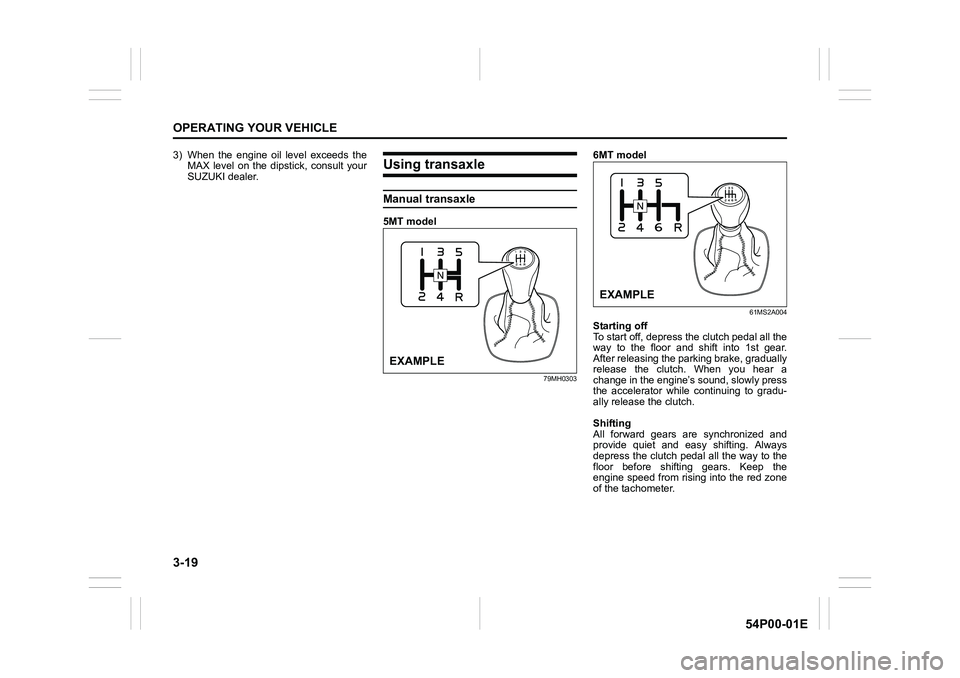
3-19
OPERATING YOUR VEHICLE
54P00-01E
3) When the engine oil level exceeds the
MAX level on the dipstick, consult your
SUZUKI dealer.Using transaxle
Manual transaxle
5MT model
79MH0303
6MT model
61MS2A004
Starting off
To start off, depress the clutch pedal all the
way to the floor and shift into 1st gear.
After releasing the parking brake, gradually
release the clutch. When you hear a
change in the engine’s sound, slowly press
the accelerator while continuing to gradu-
ally release the clutch.
Shifting
All forward gears are synchronized and
provide quiet and easy shifting. Always
depress the clutch pedal all the way to the
floor before shifting gears. Keep the
engine speed from rising into the red zone
of the tachometer.
EXAMPLE
EXAMPLE
Page 160 of 482
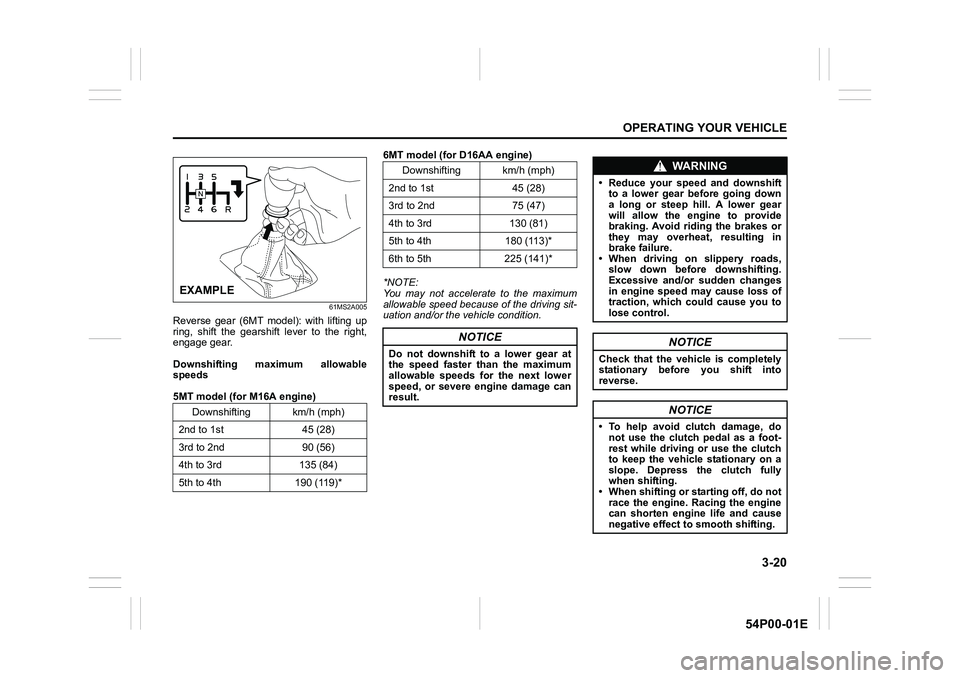
3-20
OPERATING YOUR VEHICLE
54P00-01E
61MS2A005
Reverse gear (6MT model): with lifting up
ring, shift the gearshift lever to the right,
engage gear.
Downshifting maximum allowable
speeds
5MT model (for M16A engine)6MT model (for D16AA engine)
*NOTE:
You may not accelerate to the maximum
allowable speed because of the driving sit-
uation and/or the vehicle condition.
Downshifting km/h (mph)
2nd to 1st 45 (28)
3rd to 2nd 90 (56)
4th to 3rd 135 (84)
5th to 4th 190 (119)*
EXAMPLE
Downshifting km/h (mph)
2nd to 1st 45 (28)
3rd to 2nd 75 (47)
4th to 3rd 130 (81)
5th to 4th 180 (113)*
6th to 5th 225 (141)*
NOTICE
Do not downshift to a lower gear at
the speed faster than the maximum
allowable speeds for the next lower
speed, or severe engine damage can
result.
WA R N I N G
• Reduce your speed and downshift
to a lower gear before going down
a long or steep hill. A lower gear
will allow the engine to provide
braking. Avoid riding the brakes or
they may overheat, resulting in
brake failure.
• When driving on slippery roads,
slow down before downshifting.
Excessive and/or sudden changes
in engine speed may cause loss of
traction, which could cause you to
lose control.
NOTICE
Check that the vehicle is completely
stationary before you shift into
reverse.
NOTICE
• To help avoid clutch damage, do
not use the clutch pedal as a foot-
rest while driving or use the clutch
to keep the vehicle stationary on a
slope. Depress the clutch fully
when shifting.
• When shifting or starting off, do not
race the engine. Racing the engine
can shorten engine life and cause
negative effect to smooth shifting.